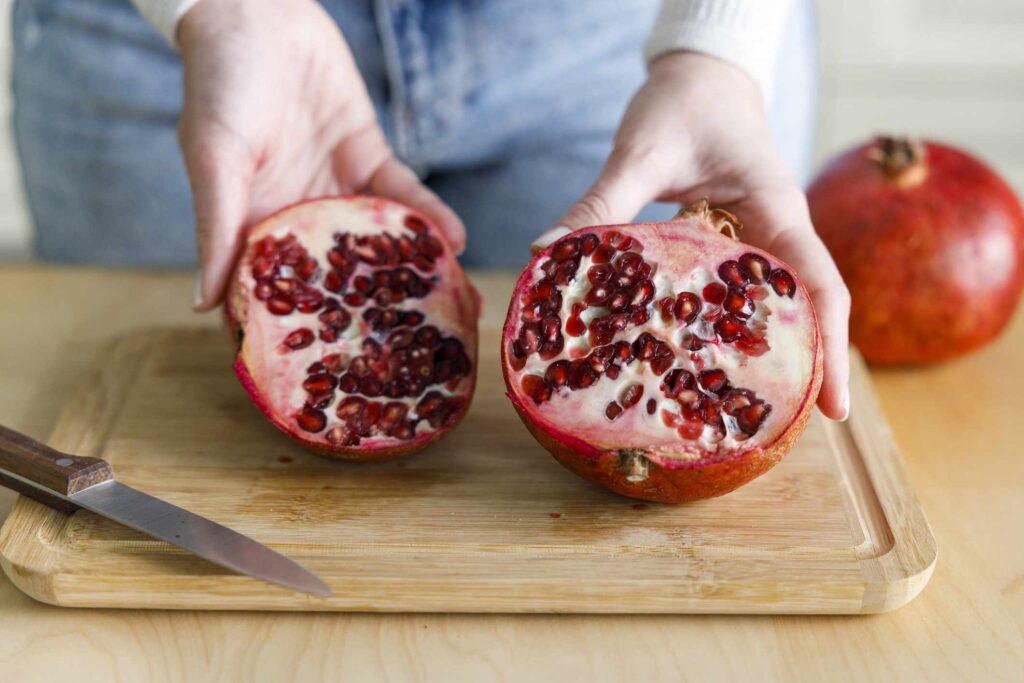:max_bytes(150000):strip_icc():format(jpeg)/Health-GettyImages-1389440410-97843650684649b5a1f1f9e48e65fabd.jpg)
When you open a pomegranate fruit (Punica granatum), you will see pomegranate seeds. These seeds are small, bright red, and juicy, with a taste ranging from tangy to sweet and berry-like, depending on their ripeness. They contain about 85% water, 10% fruit sugar, and 5% other nutrients and compounds.
Pomegranate seeds are rich in fiber, vitamin C, and potassium. They also contain phenolic compounds, which offer potential health benefits. Limited human research suggests that pomegranate products may help reduce inflammation, blood pressure, blood glucose (sugar), and cholesterol levels.
In the fall and winter, fresh pomegranates are easily found in most grocery stores.
You can incorporate pomegranate seeds into your diet for fiber, vitamin C, sweet and tangy flavor, and unique texture. Here are some ideas:
- Add to salads: Choose your favorite mixed greens and top with pomegranate seeds, sliced oranges, crumbled goat cheese, and sliced almonds
- Sprinkle on oatmeal: Boost the nutrition of your morning oats with nut butter, pomegranate seeds, chia seeds, and honey
- Mix with yogurt: Layer Greek yogurt with granola, coconut, and pomegranate seeds for a nutritious parfait
- Make sorbet: Combine pomegranate juice, lemon juice, and coconut water, and freeze to a firm slush, then top with a few seeds
- Blend into smoothies: Blend the seeds with pineapple, banana, raspberries, and almond milk for a tropical fruit smoothie
- Toss with cooked grains: For a savory side dish, add pomegranate seeds, toasted pine nuts, and roasted squash to cooked quinoa or barley
Pomegranates are in season during fall and winter. When choosing a pomegranate, consider these tips:
- Look at the color: Pomegranates turn from green to red as they mature. While ripening, anthocyanins, an antioxidant, accumulate, giving the fruit its red color.
- Feel for firmness: Ripe pomegranates become soft and less resistant to cracking, so look for less firm fruits. Avoid overripe pomegranates, which may have soft, dull-colored skin with brown spots.
- Buy local: Local produce, such as at a farmer’s market, can sometimes have a longer shelf life than produce that goes through shipping travel to get to your supermarket.
- Check for damage: Fruits can be damaged during transport, which speeds decay and provides an environment for bacterial growth.
Pomegranates require some preparation before eating. The seeds can be difficult to remove, but using the proper technique can make the process quicker and easier. Cutting into the fruit randomly may also cause the seeds to break, spreading bright red juice everywhere.
Follow these steps for cutting a pomegranate and removing the seeds:
- Cut the top: Use a sharp knife to cut off the top of the pomegranate (the stem area) and remove the top piece. You should see that the white membranes (pith) divide the seeds into sections.
- Score it: Score the pomegranate peel following the membranes. The pomegranate will open, but the seeds will remain together in sections.
- Remove seeds: After opening, hold the pomegranate over a large bowl and use your fingers to remove the seeds into the bowl.
- Remove pith: While removing the seeds, the pith may come along. The pith can be bitter, so some people don’t like the taste. You can remove the pith by filling the bowl with water. The pith will float, while the seeds will sink.
Another method is to use a spoon to remove the pomegranate seeds from a halved pomegranate. Tap the spoon on the back of the pomegranate, which will help the seeds fall out.
This requires cutting the fruit in half, which may spread some juice. You can avoid the mess by making the initial cut on a cutting board placed in your kitchen sink or on top of a kitchen towel.
Other Ways To Get Pomegranate Seeds
You can also find ready-to-eat pomegranate seeds in the market, available fresh, freeze-dried, or frozen. When buying pomegranate seeds, follow these tips:
- Examine the package: The packaging shouldn’t be broken, have tears or holes, or appear discolored. Avoid items that show signs of changes in food texture, such as softening or ice crystals.
- Check the “best buy” or “use by” date: Always check the “best buy” or “use by” date to avoid buying low-quality or soon-to-expire foods. Frozen fruits generally stay safe, but their taste and texture decrease over time.
- Read the nutrition facts label: Frozen or pre-packaged fruits may contain added sugar or other ingredients. Read the nutrition facts to ensure the product is 100% pomegranate seeds without added sugars.
- Buy frozen products last: To prevent them from melting, pick up frozen pomegranate seeds as your last item before checking out at the market.
Keeping produce in the refrigerator at 41 degrees Fahrenheit (5 degrees Celsius) or less helps it last longer. A whole pomegranate can stay fresh and maintain good quality for 2-5 days in the pantry, up to three months in the refrigerator, and 10-12 months in the freezer.
Pomegranate seeds don’t have the protection of the fruit peel, so they tend to spoil faster, losing their texture and color. Depending on their quality, you can store pomegranate seeds for up to 21 days at 39-43 degrees Fahrenheit (4-6 degrees Celsius).
You can freeze leftover pomegranate seeds to make them last longer. Freezing foods below 0 degrees Fahrenheit (-18 degrees Celsius) keeps them safe for longer by stopping bacterial growth. However, the quality decreases over time, causing changes in color, taste, and smell.
When you want to eat frozen pomegranate seeds, thaw them in the refrigerator, on a countertop in a bowl or plastic bag of cold water, or in the microwave. If using a microwave, choose a “thaw” setting instead of heating them.
Some people have pomegranate allergies. Otherwise, pomegranate seeds are generally safe for most people. You may experience gastrointestinal (GI) side effects, such as diarrhea, if you eat too many pomegranate seeds at once.
Experts recommend eating at least two servings of fruit a day. A standard serving of pomegranate seeds is one-half cup, which provides:
- Calories: 60
- Protein: 1 gram (g)
- Fat: 0.25 g
- Carbohydrates: 13.5 g
- Fiber: 5.5 g
- Sugars: 7 g
- Vitamin C: 7.5. milligrams, or 12.5% of the Daily Value
Sugar is naturally found in fruit, and eating too many pomegranates might result in a high sugar intake. However, fruit juices tend to be a more concentrated source of sugar than whole fruits.
For example, one cup of pomegranate seeds (140 grams) contains 14 grams of sugar, but one 8-ounce (240 milliliters) glass of 100% pomegranate juice contains 31 grams of sugar, even without added sugars. Choosing whole fruits instead of juices can help you reach your recommended fruit intake without spiking your sugar intake.
Pomegranate seeds are rich in fiber, vitamin C, and potassium. They also contain phenolic compounds, which evidence suggests may help reduce inflammation, blood pressure, blood glucose, and cholesterol levels.
Choosing a ripe pomegranate fruit and using proper cutting techniques can help you remove the seeds quickly and easily. You can also buy pomegranate seeds in fresh or frozen forms at the market.
You can add pomegranate to your diet by incorporating it into salads, oatmeal, yogurt, smoothies, and more.













